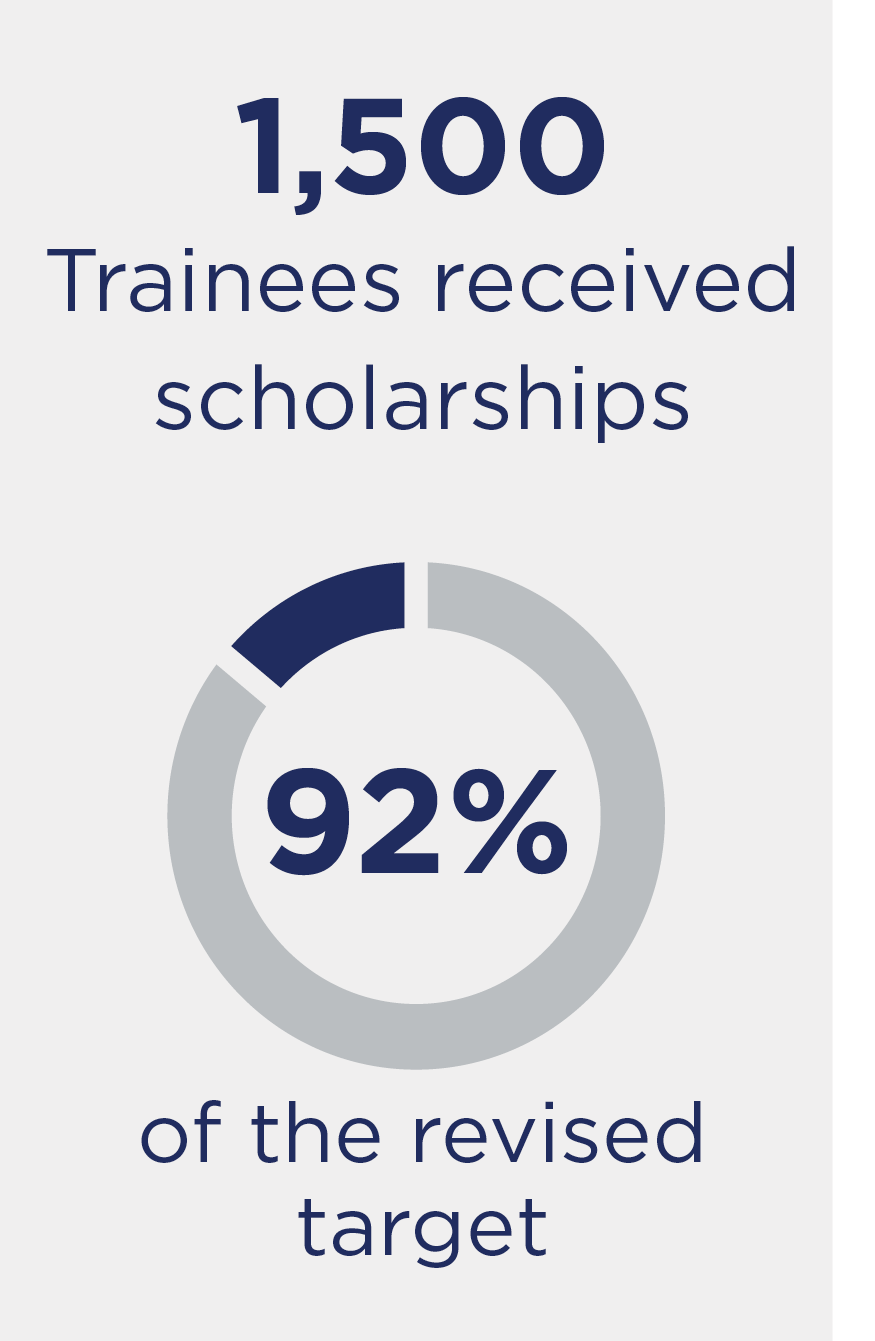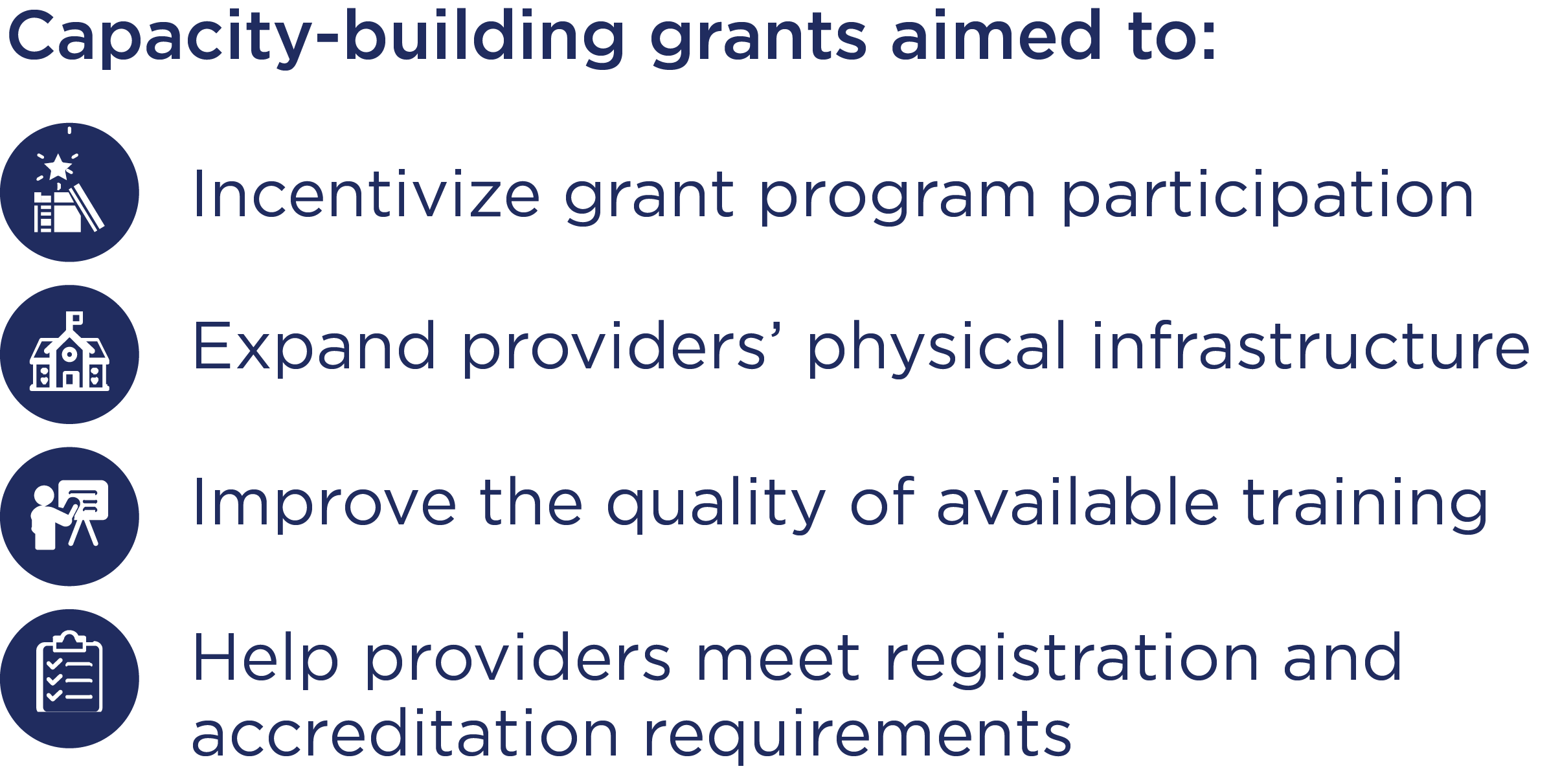Program Overview
MCC’s $295.7 million Namibia Compact (2009-2014) funded the $138.6 million Education Project, which included the $8.2 million Vocational Training Grant Fund (VTGF) Sub-Activity. The sub-activity was designed to address the skills gap in Namibia’s labor force by providing grants to expand domestic training capacity and fund scholarships in high-priority skills areas, thereby allowing more trainees to complete training and to increase employment and earnings.
Evaluator Description
MCC commissioned Mathematica Policy Research to conduct an independent interim performance evaluation of the VTGF Sub-Activity. Full report results and learning: https://data.mcc.gov/evaluations/index.php/catalog/90.
Key Findings
Vocational Training Grant Fund Implementation
- The VTGF training grants were largely implemented as planned, with approximately 1,500 trainees, or 92 percent of the revised target, receiving scholarships.
- Training targets were reduced due to the small number and capacity of training providers in Namibia. In addition, a capacity-building component was added to incentivize more providers to participate.
- A second component was added to increase attendance and reduce dropouts among trainees.
- The process for identifying market demand was unclear; the groups tasked with determining market demand did not become fully functional for all industries until after the Compact ended.
Trainee and Employer Perceptions
- Trainees viewed the scholarship program as a unique opportunity.
- Trainees and employers were positive about both trainees’ labor market prospects overall, and the Recognition of Prior Learning (RPL) program.
Namibia Training Authority (NTA) Experience
Evaluation Questions
This interim performance evaluation was designed to answer the following questions that will inform the final evaluation:
- 1
Was the VTGF Sub-Activity implemented as planned? - 2
How were the training grants managed? - 3
What were beneficiaries’ perceptions of the training grants and employers’ perceptions of graduates? - 4
Were the RPL and employer-provided training pilots implemented as planned? How did employers’ and RPL-certified employees’ perceptions change following certification?
Detailed Findings
Vocational Training Grant Fund Implementation

The training grant component of the sub-activity largely was implemented as planned, although the small market for vocational training in Namibia made it challenging to identify enough providers with the required certifications to participate and to meet the initial training target of 5,838 trainees. The training grants were intended to target high-priority skill areas determined by market demand in Namibia, but the process to determine market demand was not as scientific as planned and has not yet produced rigorous guidelines for prioritizing skills areas. Furthermore, the industrial skills committees were not fully functioning for all industries during the Compact period.

The Compact also provided capacity-building grants for training providers to improve infrastructure and equipment, and to support instructor training. The grants were intended to benefit trainees, but also to make longer-term changes. These changes included expanding the providers’ physical infrastructure, such as extra classrooms or workshops, improving the quality of available training, and enabling providers to meet the requirements for formal registration and accreditation. In addition, the grants served as an incentive for providers to participate in the grant program, many of whom initially had limited ability or interest in expanding their training slots or course offerings. Another key component was a student board and lodging allowance, which aimed to increase attendance and reduce the number of dropouts among VTGF-funded trainees. Both trainees and providers agreed that it was an important addition to the basic training grants, although the Namibia Training Authority expressed concerns about the sustainability of the allowances. Grant funds were also used to pilot the RPL program, which sought to certify the vocational skills of employees with work experience but no formal qualifications. However, it was a challenge to recruit employers to participate in the pilot, which could affect the continuation of the program under the NTF.
Trainee and Employer Perceptions
Grant recipients were overwhelmingly grateful for the opportunity to further their education and viewed the fully-funded training as a unique opportunity in the Namibian context. Trainees felt the quality of training they received was high and they would be able to translate their experience into positive labor market outcomes. The employers positively viewed the training providers that received training grants based on their previous experiences in recruiting graduates from these providers. Employers and providers noted existing relationships through which they partner for job attachments or even direct hire of trainees, although it is unlikely that all grant-funded trainees will be able to be accommodated through these relationships.
All stakeholders viewed the RPL program positively. Most program participants felt their certificates increased their job security and mobility. However, employers’ perceptions of certificate holders had not changed and no wage raises were reported.
Namibia Training Authority (NTA) Experience

The training grants were designed in part as a pilot of the NTF, which will be managed by the NTA. This experience allowed the NTA to improve its understanding of training costs, how to compare costs across providers and skill areas, and how to manage grants by setting and monitoring the progress of training providers toward concrete milestones. Some improvements to the grant fund management processes and templates were made over the course of implementation, and the Namibia Training Authority planned to use these systems to award and manage grants under the National Training Fund.
MCC Learning
It is important to identify, understand, and mitigate risks, such as the challenges for new providers entering the vocational training market.
Compacts must understand the participants they are targeting and what might interfere with their participation or adoption of new skills, and attempt to overcome such challenges, if appropriate.
Evaluation Methods

A trainee in the VTGF training program.
The qualitative implementation analysis drew on data collected from a variety of sources in October and November 2014, so the exposure period ranged between one to two months after the Compact ended. Data collection included 41 in-depth interviews, four focus groups, observations, and reviews of documents provided by stakeholders.
Interviews were conducted with MCA-Namibia staff, MCC resident country mission staff, NTA staff, technical consultant staff, training provider staff, and employers of grant-funded trainees. Focus groups were conducted with grant-funded trainees, as well as with four training providers, in which grant-funded training was still underway. People who applied to these training providers but were not selected to receive scholarships were also interviewed about similar topics to better understand the different experiences between trainees and those not selected.
Next Steps
The VTGF Sub-Activity is also the subject of an impact evaluation using random assignment, which seeks to assess impacts on key outcomes of the sub-activity, including increased completion of training in key priority skill areas, increased paid employment or self-employment, increased earnings, and increased job security and mobility. The final evaluation is expected to be available in 2017.
2021-002-2517


